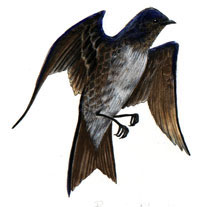 |
Martins are the most valuable natural asset to the homeowner for daytime mosquito control. They match the little bat that takes care of the same nighttime chores.
Purple martins winter in Brazil, then migrate north as our spring arrives. They appear in their previous home regions as dependably as the swallows, their cousins, return to Capistrano.
Purple Martins are comfortable around humans and continue to win our affection. They have captured our fancy since the days when Native Americans fashioned houses for them from dried, hollow gourds. Feisty and active, they repaid their benefactors by protectively driving off hawks, crows and vultures and signaling the approach of danger to human settlements. In this day and age they are also respected for their legendary appetite for pest insects, especially mosquitoes, that are resident in the open meadows and nearby water that these rural birds prefer.
Purple Martins are at home throughout the US in fields near marshes and in woods that open onto a large body of water near towns and farms from southern Canada to northern Mexico.
Recognizing Purple Martins
The largest of the North American swallows, mature purple martins are fully 7 inches long and weigh up to 2 ounces. Males are uniformly glossy blue-black above and below and they are black-bellied. Females are more brownish-black with a grayish throat and breast areas. Youngsters resemble females until their first molt in their second winter. Martins have the characteristic short necks, short, flat beaks that open very wide and pointed wings of their swallow relatives. They glide in circles, alternating quick wing flaps and gliding. Legs are small and weak because they are not used very often.
Purple martins drink and bathe on the fly, swooping down to the water and skipping along its surface.
A social bunch, martins sit along power lines and jabber, their repertoire of conversational and expressive noises, both soft and sharp fit occasions of fear, anger, sadness and joy. They are comfortable in the presence of people.
The martin makes its nest using twigs, straw, hay and leaves. The incubation period is 12 to 20 days. Natural nest sites are woodpecker holes in tree to crevices in cliffs. Will nest in apartment birdhouses or a grouping of gourds, hollowed out and positioned 15 to 20 feet high in an open area. They raise mostly one brood per year with 4 to 5 eggs but have been known to raise two broods. They nest in the northern portion of their range in May to June, the middle portion of their range in June to July and in the south, April to June. This is one bird where the male takes as active a role in building the nest as does the female. The female incubates the eggs but the male helps raise the young. They mate for the year only. The ultimate in nesting height is 15 feet from the ground.

